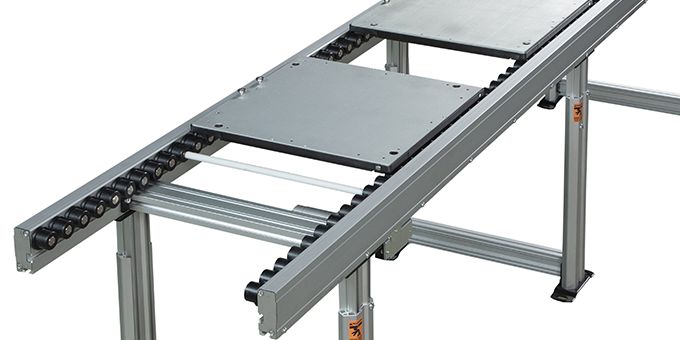The system uses rollers to move pallets smoothly, without friction (a byproduct often seen in belt-driven platforms). The conveyor's open design eliminates concerns of small parts or screws dropping into rollers and causing conveyor damage or jamming.
 Edge Roller Technology (ERT®250) Conveyor
Edge Roller Technology (ERT®250) Conveyor

Q&A with Stacy Johnson, Director of Marketing and Strategic Planning | Dorner Conveyors
What are pallet system conveyors and how are they used in manufacturing, assembly and robotic applications?
Pallet system conveyors are ideal for many automation-focused applications that require exact movements and positioning of parts, as they can be setup or programmed to start and stop at specific intervals to sync up with robotic interaction or other processes. These types of conveyors dominate in automotive component manufacturing, as well as other industries including medical devices, electrical and electronics, and product testing/inspection that call for automated and manual assembly or handling of products.
Pallet system conveyors are available in multiple styles such as dual belt configurations powered by common drives, and flexible plastic chain belt designs. Dorner’s innovative lifting modules can be used to interface with robots, change product orientation, or rotate product 90° or 180°. Companies using a pallet system conveyor are also doing so for the accuracy. They need their product at an exact location, and the conveyor’s lift and location station deliver repeatability of 0.002”. Pallet systems are available in a variety of layouts including tight turns, heavy load applications and vertical transfer units.
What is Dorner’s Edge Roller Technology (ERT®250) conveyor?
Dorner’s ERT250 is an innovative roller technology-driven conveyor system for pallet and tray handling. The system uses rollers to move pallets smoothly, without friction (a byproduct often seen in belt-driven platforms). The conveyor’s open design eliminates concerns of small parts or screws dropping into rollers and causing conveyor damage or jamming.
What applications are best suited for pallet and tray handling conveyors?
Conveyors such as the ERT250 are ideal for applications calling for no- and low-back pressure accumulation. Other applications include:
-
Tray and pallet handling
-
Medium to heavy load assembly automation
-
Cleanroom applications such as medical product or device manufacturing, assembly, packaging and others
-
Electronic and consumer goods assembly
-
Appliance manufacturing
-
Automotive assembly
What’s the difference between an edge roller and a belt conveyor?
In belted conveyors, there’s typically a fabric or modular plastic belt running on a bedplate with product positioned on top of the belt. The force to move the product includes both tension and friction – it’s this friction which can result in dusting and debris – contamination that can cause major issues for higher level cleanroom applications.
Eliminating contamination from friction is at the core of the ERT250 development. With a roller style conveyor, the force to move the product has almost no friction. The force to accumulate product with driven rollers is higher, but not as high as belted.
What gives the ERT250 an advantage over other similar type of platforms?
Certainly, one advantage of the ERT250 is found in the design of its linear gearbox. The patent-pending design features a series of upper and lower driver gears which provide roller movement, a sealed gearbox housing to eliminate contaminant in a cleanroom environment, and the ability to create conveyor zones by simply removing a lower gear.
Where belted conveyors typically require stops to keep parts separated, the ERT250 provides a more efficient method for pallet separation. With each gear there’s an opportunity to locate the drive and gearmotor on any gear and create zones where needed for the application. In other words, removing a connecting gear and creating a zone produces multiple conveyors within a single conveyor frame for non-contact zoning and accumulation.
What other factors should customers consider in selecting a conveyor supplier?
A strong conveyor supplier is one that will be there long after the sale is completed. Establishing a lasting relationship is critical toward ensuring your existing system, as well as future conveyor needs, are properly managed. Factors such as service and parts need to be considered. How fast can you obtain replacement parts, and are they readily available from the conveyor supplier? How responsive is the supplier to your needs?
Bottom line is anyone can sell you a conveyor, but for best results, you want to select a partner who will be there for you long after the installation is completed; a partner that is innovative and looking for a long-term customer relationship as well.

About Stacy Johnson
Stacy Johnson is the director of marketing and strategic planning at Dorner, a privately held Wisconsin manufacturer in the design, application and integration of low-profile conveyor platforms. She can be reached at stacy.johnson@dorner.com
The content & opinions in this article are the author’s and do not necessarily represent the views of RoboticsTomorrow
Featured Product

